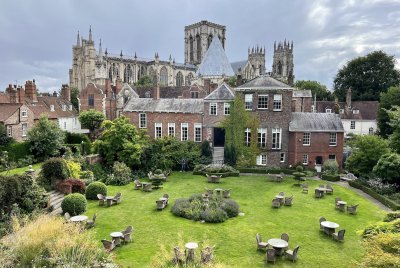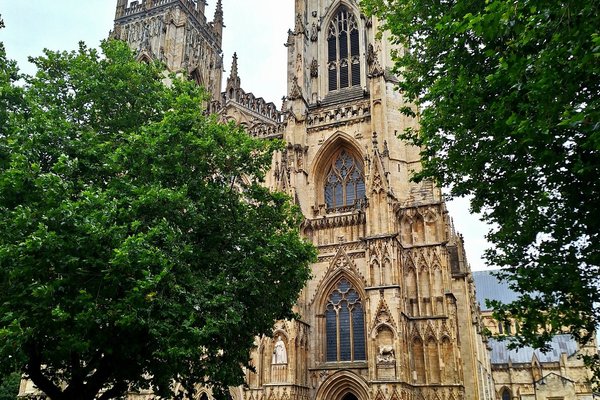United Kingdom
City of York
The historic urban core of the City of York covers surviving buildings from the Roman arrival to the present day, including Norman, Anglo-Saxon, and Victorian.
Its cathedral, York Minster, stands out, notably for its 15th-century stained glass.
Site Info
Official Information
- Full Name
- City of York (ID: 6687)
- Country
- United Kingdom
- Status
-
Nominated 2028
Site history
History of City of York
- 2024: Preliminary Assessment
- 2023: Added to Tentative List
- Added to tentative list
- Type
- Cultural
- Criteria
- i
- ii
- iii
- iv
- vi
Links
- UNESCO
- whc.unesco.org
All Links
UNESCO.org
- whc.unesco.org — whc.unesco.org
Community Information
- Community Category
- Urban landscape: Urban continuity
Travel Information
Recent Connections
News
No news.
Recent Visitors
Visitors of City of York
- Adrian Turtschi
- Ali Zingstra
- ALS
- Ammon Watkins
- Andrew_Kerr
- Argo
- basementonline
- bossc
- brornt
- campmany
- canadiantraveller
- Caspar
- CeeCeeSR
- CeeMon
- Chantal den Haan
- Cheryl
- ChrisN
- Clyde
- Dani Cyr
- Dennis Nicklaus
- Digits
- Dirk-pieter
- edstar500
- Elisabeth Fransisca Situmorang
- emvcaest
- Erik Jelinek
- Fam39
- flahr
- Gabbro
- gautamiyer23
- George Gdanski
- GeorgeIng61
- Grendel Gongan
- Hammeel
- henrik_hannfors
- Hubert
- Ian Cade
- Igloo
- Jakob F.
- James Bowyer
- James F
- Jarek Pokrzywnicki
- Jay T
- Jeanne OGrady
- Kevin Padley-Knight
- KngAlaric
- Kristin
- Kyle Magnuson
- Laurey
- Lithobates
- Małgosia Łupicka
- Martin
- Matthewsharris
- MC
- MichaelH
- Ming_9734
- MMM
- Pat Martin
- Patrik
- Piotr Wasil
- PlacesWeHaveBeenTo
- pressdm
- Priyaranjan Mohapatra
- Ralf Regele
- Randi Thomsen
- Roger Ourset
- Roman Bruehwiler
- Roman Raab
- Rudegirl
- S. Anril Tiatco
- Sclowitz
- scubarrie
- SDMArado
- Sergio Arjona
- Shandos Cleaver
- Solivagant
- Squiffy
- Ssong.x
- Stanislaw Warwas
- SteveD92
- Szabolcs Mosonyi
- Szucs Tamas
- Tarquinio_Superbo
- Ted Coombs
- Tevity
- Thomas van der Walt
- tingmelvin
- Tsunami
- Twobaconsandaboston
- voyager
- Wimmy
- Wojciech Fedoruk
- Wo_ko
- ZCTLife
Community Reviews
Show full reviews
Most countries can only envy England with their tradition and ability to preserve its rich heritage. There are certainly dozens of well-preserved medieval towns her and only Belgium, the Netherlands and parts of France may come close to it. Therefore, it is sad, that nowadays medieval heritage is lowly regarded as WH material and the UK thinks it has better cards nominating obscure wetlands or moors or a modest park than a great cathedral, a perfect town or a splendid palace that would be easily inscribed if it stood in other parts of the world.
Therefore, it is good news that, after a strange archeological nomination of York has been rejected, York nominated as a town. It has a nice, manageable size but please, do not believe that you can see even its nicest parts in one or two days. We spent four days and still have reason to go back.
The cathedral is the greatest attraction. Even, when I prefer the cathedrals of Wells, Lincoln and Ely, is this is a wonderful building, and you need easily half a day to get even an idea of its treasures. The east window is one of the great windows in the world, the refectory offers an awe-inspiring construction, and its statuary is full of riddles, even for the experts, there is a good museum, and, in the crypt, you can see parts of the former Norman cathedral.
But while this may not be the greatest English cathedral, the …
Keep reading 0 comments
York is a great little place for a weekend break. It's a compact old city that has everything, Roman and Viking remains, a Cathedral, intact city walls, river excursions and some great museums.The Shambles is one of the best preserved medieval areas in the UK with interesting narrow streets lined with half timbered buildings.York Minster, the Cathedral (picture), is an impressive building dating mainly from the 13th and 14th centuries and is built in the early English Gothic style. It is the second highest ranked cathedral in the country and the seat of the Archbishop of York.In 1984 a fire destroyed much of the cathedral but quick thinking actions by the fire brigade saw them deliberately collapsing the roof which saved the rest from certain destruction. The building today shows no effects from that devastating fire.The only downside to York is the sheer number of visitors the city receives. It's a fairly small city center and it can feel oppressive with the volume of people, particularly on a hot summer weekend when the city is full of stag night and hen night party goers as well as the influx of tourists.In terms of gaining a full WHS listing, I'm not so sure, it's a great place for a break but not on the same level as, say, Bath or Edinburgh
Keep reading 0 comments
"Eoferwic was, and still is, the chief city of northern Englaland. It possesses a great abbey, an archbishop, a fortress, high walls, and a vast market. It stands beside the River Ouse, and boasts a bridge, but ships can reach Eoferwic from the distant sea, and that was how the Danes had come." - Bernard Cornwell (The Last Kingdom) from The Saxon Stories
Curiosity from Literature
My awareness of York (or Eoferwic) was primarily through literature, as illustrated in the passage. I had acquired only a vague understanding of the World Heritage label at this time (November 2007). In the many years since, my planning has certainly been influenced and enriched substantially by World Heritage travel. However, what led me to reserve my train ticket to York was the stories I had read.
Coming South from Edinburgh, I had a full-day to explore the city. While visiting the highlights of the "Historic Urban Core" my money quickly dwindled. In 2007 the exchange rate was equivalent to £1 per $2 (USD) and nearly everything in York seemed to have a sizable ticket price! I notice in 2023, the Visit York Pass is priced at £59, which seems reasonable if you plan a full itinerary (currently with a favorable exchange rate).
Historic Urban Core (1-Day)
I prioritized the historic sites throughout the city that corresponded to various periods of York's rich history. Did I eat anything, a late breakfast, lunch? My poor travel companion! I cannot recall eating anything in York, …
Keep reading 0 comments
I was in love with a wall. York is famous for having the longest set of medieval walls in the UK, but it was not these crenelated stretches and their impressive gate towers that most impressed me. It was not the overhanging upper stories of the half-timbered houses along The Shambles that caught my eye. It was not even the preserved Roman fresco displayed in the Undercroft of the towering York Minster. No, the wall that made me catch my breath was a short stretch of woven wooden wattles, maybe four feet high. People milled around, largely oblivious, before forming into a queue for a fairground ride. But this fragment of wall formed part of a domestic house one thousand years ago. That it had been protected for so long in the sodden earth beneath York, England’s second most important city for much of its existence, was a marvel. But what added glamour and mystery were the people who had erected it. This wall dated to the period of Jorvik, the largest settlement in England of the people known as the Vikings.
The city of York has a long history. The legionary fortress of Eboracum became Eoforwic, chief city of the Saxon Kingdom of Northumbria. The Vikings ruled it as an independent fief for almost a century as Jorvik and even when it was subsumed into the Kingdom of England it maintained a distinct heritage. The city’s importance persisted throughout the medieval period, not least because York was home …
Keep reading 0 comments



